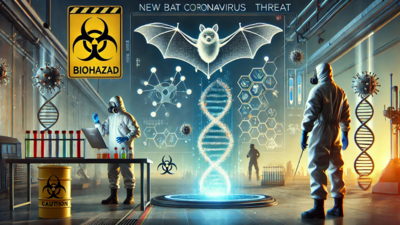
This is an AI-generated image, used for representational purposes only. (Picture credit: DALL-E)
A new
bat coronavirus
with the potential for
animal-to-human transmission
has been discovered by a team of Chinese researchers, raising concerns about possible future spillover events. The virus, named
HKU5-CoV-2
, was found to use the same human receptor as
SARS-CoV-2
, the virus responsible for Covid-19.
According to the South China Morning Post, the study was led by
Shi Zhengli
, a renowned virologist known as "batwoman" due to her extensive research on bat coronaviruses.
The research involved scientists from the Guangzhou Laboratory, Guangzhou Academy of Sciences, Wuhan University, and the
Wuhan Institute of Virology
. Their findings were published in the peer-reviewed journal Cell on Tuesday.
The newly discovered virus belongs to the
merbecovirus
subgenus, which includes the Middle East respiratory syndrome (MERS) virus. It is a new lineage of the HKU5 coronavirus, initially identified in Japanese pipistrelle bats in Hong Kong.
The research found that HKU5-CoV-2 can bind to the human angiotensin-converting enzyme (ACE2) receptor, the same receptor used by SARS-CoV-2 to infect human cells. "We report the discovery and isolation of a distinct lineage (lineage 2) of HKU5-CoV, which can utilise not only bat ACE2 but also human ACE2 and various mammalian ACE2 orthologs," the scientists wrote.
Potential spillover risk
The study warned that bat merbecoviruses "pose a high risk of spillover to humans, either through direct transmission or facilitated by intermediate hosts."
According to the researchers, HKU5-CoV-2 can bind to ACE2 receptors in multiple animal species, increasing the likelihood of interspecies transmission.
Despite its potential for human infection, the researchers cautioned against exaggerating the threat. They noted that the virus’s efficiency in binding to human ACE2 is “significantly lower” than that of SARS-CoV-2. "The risk of [HKU5-CoV-2] emergence in human populations should not be exaggerated," they said.
Earlier this month, Cell published a study by researchers from the University of Washington in Seattle and Wuhan University, which concluded that while the HKU5 strain could bind to bat and other mammalian ACE2 receptors, it did not show "efficient" binding to human ACE2.
However, Shi’s team countered that HKU5-CoV-2 appears to be better adapted to human receptors than its predecessor, lineage 1, and "may have a broader host range and a higher potential for interspecies infection," South China Morning Post reported.
Monitoring and pandemic preparedness
Given the potential risks, the researchers focused on the need for further monitoring. The World Health Organization has already included merbecoviruses on its list of emerging pathogens for pandemic preparedness.
Shi Zhengli, who played a key role in Covid-19 research, has previously denied claims that the Wuhan Institute of Virology was responsible for the pandemic.
While the origins of Covid-19 remain debated, some studies suggest the virus originated in bats and jumped to humans through an intermediate host.

 1 month ago
17
1 month ago
17










 English (US) ·
English (US) ·